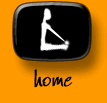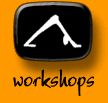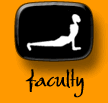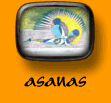

 |
 |
 |
 |
 |
 |
|
DOWNDOG | EAGLE | COBRA | HERO | HALF MOON | CORPSE | GATE
TRIANGLE | PEACOCK | LOCUST | COBBLER | SHOULDER STAND HEADSTAND | BRIDGE | CAMEL | COW FACE | UP BOW | INVERTED STAFF SEATED WIDE ANGLE | HEAD TO KNEE | TORTOISE | DANCER NOOSE  |
| Parighasana ~ Gate Latch Pose Images by Nancy Van Kanegan Parighasana is a beautifully simple yet powerful pose. Start by kneeling hips width apart (on a blanket, folded towel or doubled mat if a regular surface is hard on your knees). Extend your right leg straight out to the right side, and turn the foot to point to the right. As you press the right toes down onto or toward the floor, engage the quadriceps and pull up strongly on your right kneecap. Keep the quads pulling up the whole time so you don't jam into the back of the knee and hyperextend it. Extend the right arm to the right. Energize it by gently spreading the fingers and drawing the muscles in toward the bones and up the arm into your center as the bones stretch back through. Turn the palm up and lower the back of the right hand to the top of the right leg. Extend the left arm, energize it, turn the palm up, and lift the arm straight up so it's by your ear. Now you're ready to latch the gate. With an inhale, stretch up out of the pelvis, and as you exhale stretch up and over to the right as you turn to look up past your left upper arm. Keep the left shoulder back so it stays in line with the right one, not in front of it. With each inhale stretch the spine and top arm out and turn the rib cage more to the left. With each exhale stretch over more to the right and down over the leg, sliding the right hand more toward the foot. Keep the right leg strong with the top of the right thigh pulling into the hip. And keep pulling the left hip back to the left so the left thigh stays vertical. Remember to remain open in front with the left shoulder and ribs opening to the left and back, not dropping forward so you can get lower (this is cheating). Your goal is eventually to bring the palm of the left hand on top of the right, with both arms extended. If this is easy (it's not for me - I'm not quite there) try this. Keeping the quads pulling up, lift the toes and stretch out evenly through both the heel and the ball mounts of the right foot. Turn the right palm more to the right and grab the inner right foot with the right hand, then grab the outer foot with the left hand (or just keep stretching the left arm toward the foot). Using the arms as levers, twist up more to the left. (This is something like parivrtta janu sirsana, if you know that pose). No matter where you are in gate pose, work it for 5-8 breaths, then stretch up with an inhale, and switch sides. In the Ashtanga version, you would start with the left leg extended along the floor, and the right leg bent back, with the knee and top of the foot on the floor, and opening away from the left leg. You then bend sideways over the left leg, either extending the arms and opening up or grabbing the left foot with the hands and twisting up as in the other version. As the name implies, parighasana makes you steadfast. The kneeling leg is like a post to which the bar or latch fastens, holding the gate of the torso in place so you can get the full benefit of the stretch. I find this pose a wonderful prep for triangle (trikonasana) because it opens many of the same areas - some even more intensely - without putting as much strain on the legs. So next time you're feeling a little stiff in the hips, swing the gate open and closed a few times, and you'll be ready for anything. Text by Tim
Noworyta |
||
|
E-mail: info@yogamind.com | Return Home :: mindfully designed by braddon.com :: |